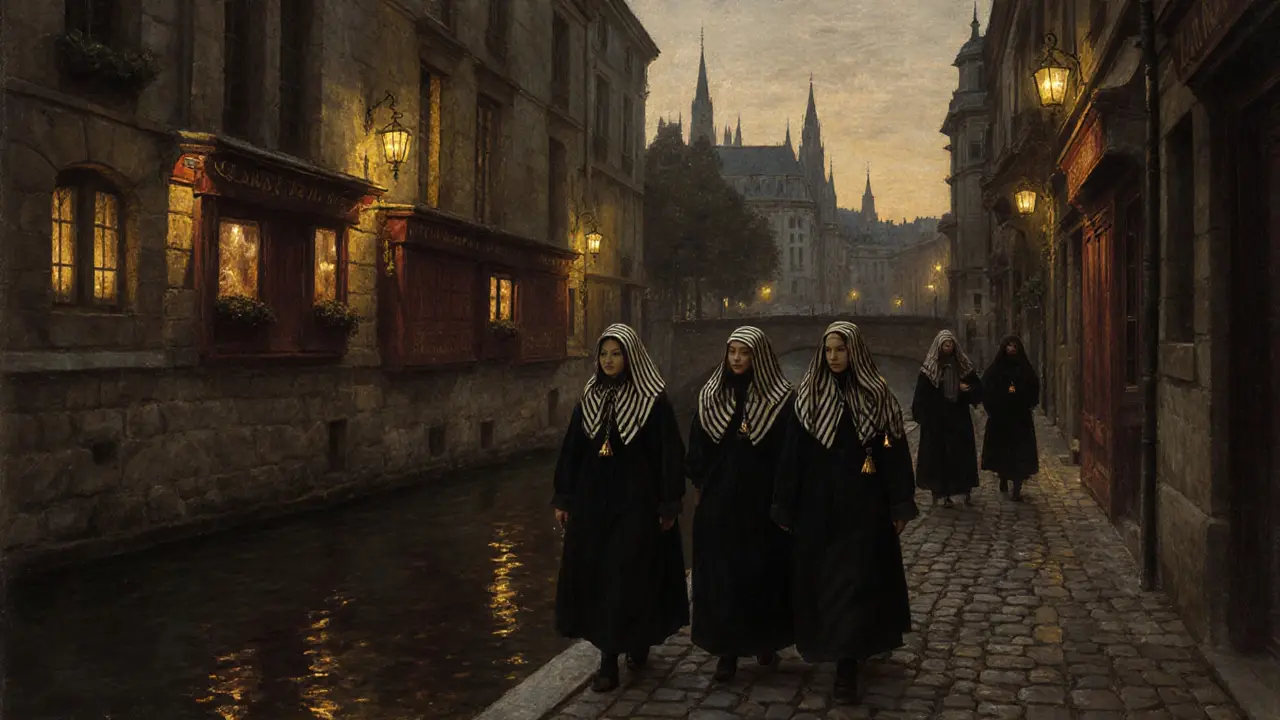Paris has always been a city of allure, art, and secrets. But behind its cobbled streets and glowing café lights lies a hidden thread woven through centuries: the presence of escorts. Not just as a modern phenomenon, but as a deeply rooted part of Parisian life since the Middle Ages. This isn’t about sensationalism. It’s about understanding how society, power, and desire shaped the roles women-and sometimes men-played in the shadows of one of the world’s most romantic cities.
Medieval Paris: The First Professional Companions
In 13th-century Paris, prostitution wasn’t illegal-it was regulated. The city had designated brothels called bordels, mostly clustered near the Seine and along the city walls. These weren’t hidden dens; they were licensed establishments. Women working in them were called filles de joie-girls of joy-and were required to wear specific clothing, often striped hoods or bells, to mark their status. This wasn’t punishment. It was control. The Church and city officials saw them as necessary evils, a way to keep respectable women safe from unwanted advances.
Some of these women rose beyond their station. A few became known for their wit, beauty, or connections to nobility. One of the earliest recorded examples is Marie de France, a noblewoman who, despite her title, lived openly as a companion to wealthy merchants and minor royals. She didn’t hide her role. She used it to build influence. Her story wasn’t unique. In a time when women had few legal rights, companionship was one of the few paths to financial independence.
The Renaissance and the Rise of the Courtesan
By the 1500s, Paris had shifted from brothels to salons. The courtesan emerged-not as a streetwalker, but as a cultured companion. These women were educated, spoke multiple languages, and could debate philosophy, poetry, and politics. They didn’t just offer sex. They offered companionship, intellectual stimulation, and access to elite circles.
La Belle Otero became one of the most famous in the late 1800s, but her roots trace back to earlier figures like Madame de Pompadour, who, though officially the mistress of Louis XV, operated more like a high-end escort with political power. She controlled appointments, influenced art, and shaped fashion. Her salon was a hub for artists, writers, and diplomats. She wasn’t just sleeping with the king-she was running parts of the government.
These women didn’t need to hide. They lived in grand townhouses on the Rue Saint-Honoré. They commissioned portraits from famous painters. Their names appeared in gossip columns. In Paris, being an escort wasn’t shameful-it was a career, if you were smart enough to play the game.

The 19th Century: The Golden Age of the Demimonde
The 1800s were the peak. Paris was transforming. Haussmann’s renovations tore down old neighborhoods and built wide boulevards lined with theaters, cafés, and luxury boutiques. The demimonde-the world of half-lives-flourished. Women known as grisettes worked as seamstresses by day and companions by night. They didn’t call themselves prostitutes. They called themselves amies-friends.
Artists like Degas, Manet, and Toulouse-Lautrec painted them. Writers like Zola and Balzac wrote about them. They appeared in newspapers, operas, and novels. They were romanticized, demonized, and idolized-all at once.
One of the most famous was La Païva, a Portuguese-born courtesan who married into nobility after amassing a fortune through relationships with bankers and aristocrats. She owned the Hôtel de la Païva on Avenue Foch, one of the most opulent homes in Paris. Her parties were legendary. She hosted princes, poets, and industrialists. When she died, her estate was worth more than the French royal treasury at the time.
These women weren’t victims. Many were entrepreneurs. They negotiated contracts, hired managers, and invested in real estate. They understood that their value wasn’t just physical-it was social. They built networks. They leveraged connections. They turned intimacy into capital.
20th Century: Criminalization and Underground Survival
By the 1940s, attitudes shifted. The French government passed laws to shut down brothels. In 1946, the Loi Marthe Richard banned organized prostitution. The goal was moral reform. The result? The escort industry didn’t disappear-it went underground.
Women moved from brothels to apartments. They used phone lines, word of mouth, and later, classified ads in newspapers like Le Parisien. The term escort began replacing prostitute-a linguistic shift to make the work sound more respectable. It worked. Clients no longer called them filles. They called them compagnes.
During the 1960s and 70s, Paris became a hub for international travelers. American and British tourists sought out the “Parisian experience”-which often meant hiring a companion for dinner, a walk along the Seine, or a night in a quiet hotel. The city didn’t crack down. It looked the other way. The police knew who was who. They didn’t arrest unless there was public disturbance.

Modern Paris: Digital, Discreet, Diverse
Today, the escort scene in Paris is quieter but more complex. There are no red-light districts like in Amsterdam. No streetwalkers on Montmartre. Instead, you’ll find women advertising on encrypted apps, private websites, and curated platforms. Many operate as independent contractors. Some have degrees. Some speak three languages. Some specialize in business travelers who need someone to accompany them to dinners, galas, or cultural events.
Unlike the past, modern escorts rarely rely on physical appearance alone. Personality, discretion, and cultural knowledge matter more. A client might hire someone not because they want sex, but because they want to feel like they’re experiencing Paris through the eyes of someone who lives it.
One woman, who goes by the name Clara (a pseudonym), works with corporate clients. She has a master’s in art history. She takes clients to private museum viewings, recommends hidden bookshops, and teaches them how to order wine like a local. She charges €500 an hour. She says, “I’m not selling my body. I’m selling my knowledge of this city.”
There are also male escorts, transgender companions, and non-binary providers. The market has diversified. The stigma remains, but it’s fading. Younger generations see it as a service industry-not a moral failing.
Why This History Matters
Understanding the history of escorts in Paris isn’t about voyeurism. It’s about recognizing how women have carved out space in a world that rarely gave them power. From medieval brothels to modern apps, these women adapted, survived, and sometimes thrived. They used their bodies, yes-but also their minds, their charm, and their resilience.
Paris didn’t just tolerate them. It celebrated them-in art, in literature, in architecture. Their presence shaped the city’s culture. The Louvre’s paintings, the cafés of Saint-Germain, the fashion houses of the Right Bank-they all have roots in the lives of women who walked the line between scandal and sophistication.
Today, when you sit at a café on the Left Bank and watch a woman in a tailored coat walk past, you might never know if she’s a lawyer, a student, or an escort. And that’s the point. In Paris, identity has always been fluid. So has desire.
Were escorts legal in historical Paris?
Yes, for centuries. From the Middle Ages through the 19th century, prostitution was regulated, not banned. Brothels were licensed, and workers had to register with authorities. The city saw them as a way to control vice, not eliminate it. That changed in 1946 with the Loi Marthe Richard, which outlawed brothels and organized prostitution.
What’s the difference between a courtesan and a prostitute in historical Paris?
Courtesans were high-status companions who offered intellectual and social engagement alongside intimacy. They lived in luxury, mingled with nobility, and often had long-term patrons. Prostitutes worked in brothels or on the streets, had little social mobility, and were subject to stricter controls. The line was clear: courtesans were part of elite culture; prostitutes were considered a public nuisance.
Did famous artists and writers really interact with escorts?
Absolutely. Artists like Toulouse-Lautrec painted courtesans in Montmartre. Writers like Émile Zola based characters on real women he met in Parisian salons. Oscar Wilde had relationships with male escorts. These weren’t secret affairs-they were part of the cultural fabric. Their work helped immortalize these women, even if society later tried to erase them.
Are escorts still visible in Paris today?
No, not in the traditional sense. There are no red-light zones. No street solicitation. Modern escorts work privately, often through apps or referrals. They avoid public attention. Many blend into everyday life-working in cafes, galleries, or offices during the day. Discretion is the norm.
Why do people hire escorts in Paris today?
Reasons vary. Some want companionship during business trips. Others seek cultural insight-someone to show them hidden corners of the city. Some are lonely, or curious, or just want to feel understood. For many, it’s not about sex. It’s about connection, confidence, or a break from routine. Paris offers a unique blend of romance and anonymity, which makes it a natural setting for this kind of service.

